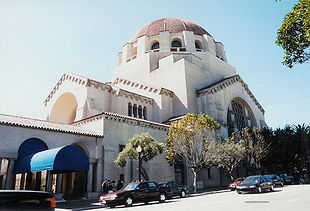Congregation Emanu-El (San Francisco)
| Temple Emanu-El | |
|---|---|
 |
|
| Basic information | |
| Location | 2 Lake Street, San Francisco, California, United States |
| Geographic coordinates | 37°47′14″N 122°27′35″W / 37.7872°N 122.4597°WCoordinates: 37°47′14″N 122°27′35″W / 37.7872°N 122.4597°W |
| Affiliation | Reform Judaism |
| Country | United States of America |
| Status | Active |
| Website | http://www.emanuelsf.org |
| Architectural description | |
| Architect(s) | Arthur Brown Jr. |
| Architectural style | Byzantine Revival |
| Completed | 1926 |
| Specifications | |
| Dome(s) | 1 |
| Dome height (outer) | 150 feet |
Congregation Emanu-El of San Francisco, California, is one of the two oldest Jewish congregations in California.
During the Gold Rush in 1849, a small group of Jews held the first High Holy Days services on the west coast of the United States in San Francisco. This group of traders and merchants founded Congregation Emanu-El sometime in 1850, and its charter was issued in April, 1851. The 16 signatories were mostly German Jews from Bavaria.
In 1884 Julie Rosewald became America's first female cantor when she began serving in Emanu-El, although she was not ordained. She served as a cantor there until 1893.
As the Reform Movement in Judaism spread in the United States during the early Twentieth Century, the synagogue became affiliated with this framework. Among its major programs today, the synagogue includes strong support for Israel, with a number of trips and related activities. As with many Reform congregations, there is also a major emphasis on social justice with the congregation's Tzedek Council (social justice council), such as the 2016 Tikkun Tikvah effort to reform California's criminal justice system, and ongoing work to advocate for the rights of refugees and immigrants.
...
Wikipedia
